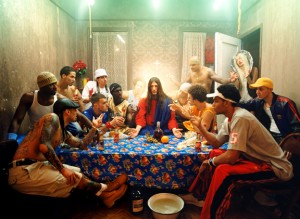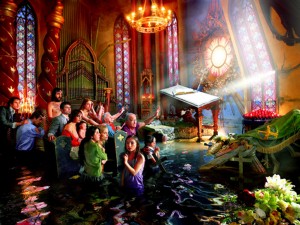« Reviews
David Lachapelle: Entropic Visuality

David Lachapelle. Last Supper, 2003. Courtesy 212 Productions. Copyright 212 Productions SA de CV. All Right Reserved 2008
Delirium of Reason
Centro de Arte Antiguo Colegio de San Ildefonso, Mexico City.
February 2 - June 14, 2009
By Thiago Alves
The Centro de Arte Antiguo Colegio de San Ildefonso in Mexico City is exhibiting for the first time in that country the oeuvre of David Lachapelle. The show, “Delirium of Reason,” includes large-format photographs that comprise part of the book, Heaven to Hell (2006), the final title of a trilogy that started with publication of LaChapelle Land (1996), and was followed by Hotel LaChapelle (1999). The exhibition, comprised of 64 pieces produced between 1995 and 2008, offers a clear panorama of his best iconography.
Lachapelle is not synonymous with Federico Fellini, although the comparison may be tempting because it sounds impressive.The Italian moviemaker was a conceptualist of visual discourse, a humanist, improviser ad limitum, who constructed his extravagant lyricism obsessed by the interaction between fantasy and subjective reality. He departed from this world in 1993; thus, he can no longer provide any explanations.
The perception of David Lachapelle, however, is diametrically opposed: the American photographer is an iconic interpreter, whose frontiers progress from the formulation of the spectacular. Whereas Fellini has gone down in history as a visualist supported by theses, Lachapelle elects to express himself through verdicts.

David LaChapelle. Catedral, 2007. Courtesy 212 Productions. Copyright 212 Productions S.A. de C.V. All Right Reserved 2008
The subjectivity manifest in Lachapelle’s discourse is an artistic response to the new ecology of typified identities based on notions of the end of time. It is a responsorial dynamic, from whence he ponders, reflects on and accepts, but never rejects; it is his direct response based on a most extreme fabulation of urban psychology and the “neo-tribal city mentality.”
In this sense, the oeuvre of the renowned photographer increasingly approximates “social reality,” because he abstracts mannerisms and objectifies environments in favor of a discourse that stresses the unbridled individuality of the creator. In his iconosphere, the life of forms becomes increasingly independent in order to achieve outlandish formalist symbolism with a marked surrealist vocation.
His iconosphere has managed to reinforce identity concretions that function like referents of a culture under construction, of a variety of ideals, of a visual fantasy land negotiated based on dissidences of a post modern culture. Lachapelle’s images are dominant representations, created to be seen from the erogenous zone of the subconscious; it is a visuality controlled to impose the object on us. In this sense, he is an artist closer to Lacan than to Fellini.
A long photographic tradition exists in Mexico with Lola Álvarez Bravo, Graciela Iturbide, Flor Garduño, Marcela Tabeada, Adela Goldbar, Ingrid Hernández, Tania Candían, etc., among the feminine figures. For their part, men have been represented by Manuel Álvarez Bravo, Agustín Casasola, Nacho López, Julián Carrillo, Gabriel Figueroa, Enrique Segarra, Pedro Valtierra, Pedro Meyer. This justifies the exhibition and the interest of a public accustomed to visual fabulation.
The influx of thousands of visitors to Lachapelle’s exhibition is due to its discursive novelty within photography and, above all, to the universality of “urban tribalisms,” globalized by the flood of images… in this urgent digital society.
Thiago Alves: Independent art critic. BA in Art History (University of Havana). MA in Communications and Digital Journalism (Carlos III University / Autonomous University of Barcelona, Spain). Director of the Masters Program in Contemporary Visual Studies, (CEDAP, Mexico)
Filed Under: Reviews


































